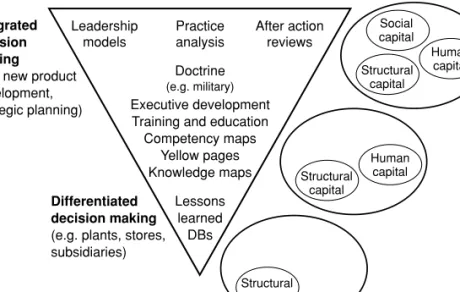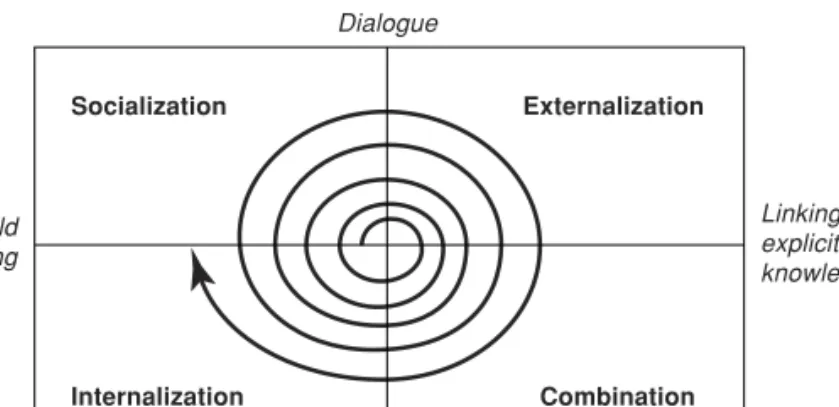The book is organized around three themes critical to the success and meaning of knowledge management: strategy, process, and metrics. The following steps describe how this collection can be used to help start a knowledge management program in your organization. Finally, Carol Willett provides a case study of implementing a knowledge management program at StorageTek.
Cognitive, social and organizational learning processes are essential to the success of a knowledge management strategy.
Where Other Efforts Have Failed?
As a chorus, they warn that we will seriously stumble if we don't pay attention in profound new ways to what we always want to ignore: the human dimension. 1 Knowledge is created by people (An article title says it better: "Sharing knowledge is human behaviour.") If we want to work with knowledge, we must pay attention to human needs and dynamics. Perhaps we should call it "Human knowledge" to remind ourselves what it is.) This learning is filled with implications for our practice. A common problem with most KM programs,' writes David Skyrme, 'is that individuals do not share their knowledge.' But we're happy to share what we know if we think it's important for the job, if we feel encouraged to learn, if we want to support a colleague.
In this respect, the creation of new knowledge is as much about ideals as it is about ideas.” We really need to consider this wisdom.
Complex Concept
Knowledge management has definitely taken its place as one of the fundamental elements necessary for developing a strategy. The integration of knowledge management processes and principles into business strategy has significant measurable benefits outlined in his paper 'The Knowledge Advantage'. David certainly helps to advocate for knowledge management as a real part of the business management process and strategic thinking. I particularly like their definition of knowledge management - 'the thoughtful design of processes, tools, structures, etc., with the intent to increase, innovate, the use of knowledge represented in any of the three elements of intellectual capital, share or improve. ”.
Knowledge management is just another step in a continuum of the ever-evolving business management process.
Building Learning Organizations
What distorts the system so much is time,” observed Stalk—multiple delays between events and responses. The traditional authoritarian image of the leader as the "boss who decides" has been recognized for some time as too simplistic and inadequate. Imagine that your organization is an ocean liner and that you are the "leader". What is your role.
Similar problems arise with the "visionary strategist," the visionary leader who sees patterns of change as well as events.
Reflection on “A Leader’s New Work
Building Learning Organizations”
Everyone talks about leadership and everyone thinks it is critical to strategy, critical to how organizations evolve, critical to developing learning cultures. Robert Greenleaf has written beautifully about "the servant leader," serving those who are led and serving a higher purpose. The abstract version says that "leadership is the ability of a human community to create its future." The operational definition states that "leadership is the ability of people in an organization to initiate and sustain significant change, to work effectively with the forces that shape change." In this sense, leadership and change are inseparable.
These are the "internal networkers", the people who spread new ideas, who connect innovative line leaders with each other, who work quietly and behind the scenes to support important new initiatives. It does not deal with the conceptualization or sense-making that is also essential for learning. This is the meat and potatoes of systems dynamics, the approach to understanding complex human systems that has been developed at MIT and elsewhere for forty years.
This is how you go from the tacit knowledge of the people in a system to a meaningful conceptualization of how that system currently works. I think consultants and academic researchers can help, but I think this is something that will turn out to be an essential task for management. This theory may deal with specific processes such as product development or distribution, or it may be of more general concern, such as what Drucker called "the theory of the business". But the important point is that the theory is grounded in human experience and that it is constantly tested against that experience.
For me, Nonaka and Takeuchi's framework opens up these kinds of problems; these are questions I hadn't thought about when the original article "The Leader's New Work" was written. However, it is really important to distinguish between the two goals, namely assessing for learning versus assessing for evaluation.
Developing a Knowledge Strategy: From Management to Leadership
Almost every organization has good examples of knowledge management practice, even if they are called something else. This second thrust of the knowledge strategy is the most difficult, but ultimately has the best potential for improving company performance. PriceWaterhouseCoopers is typical of the few consultancies that have knowledge databases to allow knowledge sharing.
A consistent thread through the levers of strategy is that different types of knowledge are involved. One of the practical problems of developing knowledge strategies or adding a knowledge dimension to other strategies is the complex nature of knowledge. There is a real understanding of the knowledge advantage and knowledge concepts (eg, tacit and tacit), its organizational processes, how other organizations are approaching knowledge management.
It portrays the role of knowledge in the success of an organization and describes the main activities and responsibilities for its management. Forward-thinking organizations are recognizing the need to more systematically measure knowledge contribution. This chapter has discussed the crucial role of knowledge as an element of business strategy.
Knowledge management provides a metaphor for the future that goes far beyond the immediate fashion of knowledge management. Examples include Knowledge Inc., Knowledge Management, Knowledge Management review, KM World, Journal of Knowledge Management.
Building Intangible Assets: A Strategic Framework for Investing in Intellectual
To integrate the concept of intellectual capital into an organization's business strategy, executives need a definition of the concept that is clear, actionable, and comprehensive. Knowledge management” is more operational in nature and follows strategic decisions about which elements of intellectual capital to invest in. Knowledge management can be seen as the deliberate design of processes, tools, structures, etc. to use, innovate, share or improve knowledge represented in one of the three elements of intellectual capital.
One of the most overlooked aspects of building intellectual capital is the fact that different types of knowledge are interdependent and affect each other's value and performance in an organization (see figure 4.3). Except in rare cases, the development of an element of intellectual capital will be insufficient because, ultimately, the interaction of structural, human and social capital determines the value of management's investment. The interdependence of the elements of intellectual capital means that building resources often requires indirect investment by developing another type of knowledge.
In other words, effective organizational learning is the result of management's explicit efforts to build intellectual capital in support of the firm's strategy. For example, an office furniture manufacturer that derives competitive advantage from its reputation for high-quality products combines all three elements of intellectual capital to create highly effective work practices. One way to follow this approach to building intellectual capital is with a small prototype designed to test a future business concept and develop an understanding of the work practices involved.
Recent definitions of intellectual capital have mainly emphasized two types of knowledge: human and structural capital. For a detailed overview of the theory of "social capital", see "Social Capital, Intellectual Capital and the Organizational Advantage", by J.

Knowledge Sharing Is a Human Behavior
Ideally, the creation of a knowledge management system is driven by the business context. Wherever he is in the organization, he must have direct access and visibility to the highest levels of the organization. They are responsible for and are rewarded for the knowledge exchange activities of employees in their business unit.
If it is a normal and expected part of the business, then it will probably be done. All training courses should require the use of a knowledge management system to model and encourage its use. The knowledge management system itself can be an important transmitter of relevant cultural messages by conveying stories of successful knowledge sharing.
Tara Jantzen, one of our Knowledge Managers, posted a question in a discussion database within our knowledge management system: “What would best motivate you to contribute to the knowledge management system?” The answers, recorded in 1997, varied and reflected many of the factors already discussed in this article. The content of the knowledge created by each form of knowledge conversion is, of course, different (see Figure 6-3). The role of the organization in the organization's knowledge creation process is to provide the right context for facilitating group activities and the creation and accumulation of knowledge at the individual level.
These examples show that the first stage of the organizational knowledge creation process corresponds to socialization. The importance of the knowledge-action relationship has been recognized in the field of artificial intelligence. Brown (1992) asserts that "The organizations of the future will be 'knowledge refineries' where employees will synthesize understanding and interpretations from the sea of information that threatens to overwhelm them from all sides" (p. 3).
Piaget (1974) points to the importance of the role of contradiction in the interaction between subject and environment.

Reflection on Knowledge Management from Japan